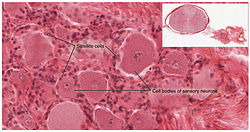What are satellite cells aka myosatellite cells?
"Myosatellite cells or satellite cells are small mononuclear progenitor cells with virtually no cytoplasm found in mature muscle. Satellite cells are precursors to skeletal muscle cells, able to give rise to satellite cells or differentiated skeletal muscle cells, although other cells in the skeletal muscle also have this capacity such as pericytes. They have the potential to provide additional myonuclei to their parent muscle fiber, or return to a quiescent state. More specifically, upon activation, satellite cells can re-enter the cell cycle to proliferate and differentiate into myoblasts.
Myosatellite cells are located between the basal lamina and sarcolemma of muscle fibers, and can lie in grooves either parallel or transversely to the longitudinal axis of the fiber. Their distribution across the fiber can vary significantly. Non-proliferative, quiescent myosatellite cells, which adjoin resting skeletal muscles, can be identified by their distinct location between sarcolemma and basal lamina, a high nuclear-to-cytoplasmic volume ratio, few organelles (e.g. ribosomes, endoplasmic reticulum, mitochondria, golgi complexes), small nuclear size, and a large quantity of nuclear heterochromatin relative to myonuclei. On the other hand, activated satellite cells have an increased number of caveolae, cytoplasmic organelles, and decreased levels of heterochromatin. Satellite cells are able to differentiate and fuse to augment existing muscle fibers and to form new fibers. These cells represent the oldest known adult stem cell niche, and are involved in the normal growth of muscle, as well as regeneration following injury or disease.
In undamaged muscle, the majority of satellite cells are quiescent; they neither differentiate nor undergo cell division. In response to mechanical strain, satellite cells become activated. Activated satellite cells initially proliferate as skeletal myoblasts before undergoing myogenic differentiation. ..." ![]() Myosatellite cell
Myosatellite cell ![]()
Presently, there are many researchers studying the satellite cells (myosatellite cells) in horses. The reference links, below, will provide you with more information.
The aging horse: effects of inflammation on muscle satellite cells.The aging horse: effects of inflammation on muscle satellite cells.
Muscle satellite cells are activated after exercise to exhaustion in Thoroughbred horses.
The effect of moderate exercise on equine muscle satellite cells in vitro
Isolation and characterization of equine satellite cells
A simplified but robust method for the isolation of avian and mammalian muscle satellite cells


